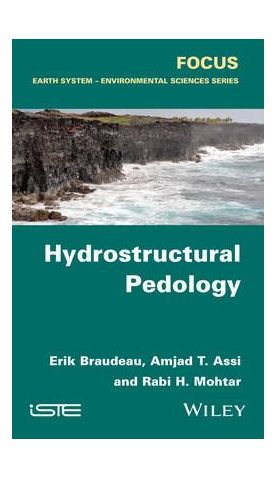אנו משתמשים ב-Cookies כדי לשפר את החוויה שלך. כדי לקיים ההנחיה החדשה של e-Privacy, עלינו לבקש את הסכמתך להגדיר את ה-Cookies. קבלת מידע נוסף.
694.00 ₪
Hydrostructural Pedology
694.00 ₪
ISBN13
9781848219946
יצא לאור ב
London
זמן אספקה
21 ימי עסקים
עמודים
184
פורמט
Hardback
תאריך יציאה לאור
17 ביוני 2016
This book presents an in-depth guide to the subject matter and main points of hydrostructural pedology, as theorized for the first time. The authors focus on the underlying concepts, the purpose and role this field plays within agroenvironmental sciences. It is divided into two parts.
Part 1 presents the theory behind hydrostructural pedology. The systemic approach applied to the soil is presented, showing how this leads to the thermodynamic formulation of water in the soil's organized medium and to the systemic modeling of soil-water-coupling in natural or anthropic organizations.
Part 2 presents the methodology to complement the first part. In it, the authors determine the hydrostructural characteristics of the pedostructure, characteristic parameters of equilibrium state equations and the hydrostructural functioning of the soil.
| עמודים | 184 |
|---|---|
| פורמט | Hardback |
| ISBN10 | 1848219946 |
| יצא לאור ב | London |
| תאריך יציאה לאור | 17 ביוני 2016 |
| תוכן עניינים | Preface ix Part 1. Theory of Systemic Modeling of the Pedostructure within the Hierarchal Hydrofunctional Organization of the Natural Environment 1 Chapter 1. Introduction to Part 1 5 Chapter 2. Inherent Problems of Soil Science 9 2.1. History of pedology 9 2.2. Modeling of water transfers in the soil: supremacy of pedotransfer functions 11 2.3. Absence of a unitary theory of the description of soil 12 Chapter 3. The Systemic Approach Applied to Pedology 17 3.1. The Bertalanffy project and Le Moigne s general system model 17 3.1.1. The general system theory and Cartesian precepts 17 3.1.2. Systemic representation: Le Moigne s two great ideas 22 3.2. The systemic description of the soil organization 25 3.2.1. Physical definition of a system 25 3.2.2. Graduation of spatial axes: the systemic description of soil 28 3.2.3. Systemic modeling of the operating system (OS) on axis III 32 3.2.4. The Structural Representative Elementary Volume (SREV) concept required for the systemic description of the pedon 35 3.3. Systemic physics of the organized soil medium defined on axis III 39 3.3.1. The thermodynamic system of the pedostructure 39 3.3.2. Equations of the hydrostructural equilibrium of the pedostructure 41 3.3.3. Determining hydrostructural soil parameters 44 3.3.4. Equations of the hydrodynamic functioning of the pedostructure 45 3.3.5. The Kamel(R) model of the hydrostructural functioning of a pedon 50 3.4. Systemic mapping of soil in the landscape 54 3.4.1. Hierarchical hydrofunctional mapping units of the landscape 54 3.4.2. The SIRS-Soils 57 Chapter 4. The General System (GS): General Model of Scientific Disciplines Related to the Study and Management of Natural Areas 59 4.1. The human system, system of study or management of a natural area, isomorphic to the general system 59 4.2. Natural systems, OSs of the GS 61 4.3. Information systems of human systems implemented for the study or management of natural systems 62 4.4. Hydrostructural pedology and its own spatial reference information system: the SIRS-Soils 64 Chapter 5. Emergence of a New Scientific Discipline: Hydrostructural Pedology 67 5.1. Where hydrostructural pedology fits into the natural sciences 67 5.2. Specificity of the hydrostructural pedology laboratory 70 5.2.1. Hydrostructural characterization of the pedostructure 70 5.2.2. Experimental analysis of the bio-soil association in the soil column 72 5.2.3. Simulation of processes at the scale of the pedon using a lysimeter 72 Chapter 6. Implications for Agro-environmental Sciences 75 6.1. A unitary theory on the systemic and thermodynamic approaches within the natural environment 75 6.1.1. Modeling in the natural environment and Cartesian precepts 75 6.1.2. Systematization, theoretical basis of the systemic approach 79 6.1.3. Theoretical and applied systemology 81 6.1.4. General Systems theory of the agro-environmental disciplines 86 6.1.5. Systemic thermodynamics 88 6.2. The new challenge to agro-environmental modeling 92 Part 2. Hydrostructural Characterization of Soil Pedostructure 95 Chapter 7. Introduction to Part 2 99 Chapter 8. Theoretical Recall 103 8.1. Pinpointing the problem 103 8.2. Modeling micro- and macro-water types by the shrinkage curve 104 8.3. New principle for determining the micro-and macro-water types using the retention curve 107 8.3.1. Micro/macro thermodynamic and hydrostructural equilibrium 107 8.3.2. Equations for the retention curve 108 8.3.3. Equations for the pF curve 112 8.3.4. Equations for the shrinkage curve 114 8.3.5. Equations for hydric conductivity 117 Chapter 9. Methods for Determining the Characteristic Parameters 123 9.1. Soil water retention curve WRC 123 9.1.1. Measured using the tensiometer (suction-based method) 123 9.1.2. Measured under air pressure on the porous plate press (pressure-based method), extending the WRC measurement beyond the 1,000 hPa tensiometric limit 131 9.2. The shrinkage curve 135 9.2.1. Case of non-sigmoidal shrinkage curves 135 9.2.2. Case of the sigmoidal shrinkage curves 144 9.3. The hydric conductivity curve of the pedostructure 149 9.3.1. Description of the Excel sheets 149 9.3.2. Procedure. 152 9.3.3. Results 153 Conclusion 157 Bibliography 159 Index 165 |
| זמן אספקה | 21 ימי עסקים |



Login and Registration Form